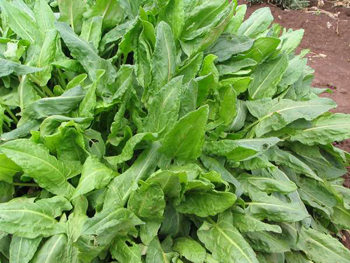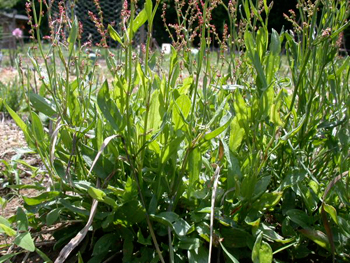Contents:
Common Names | Parts Usually Used | Plant(s) & Culture | Where Found | Medicinal Properties | Biochemical Information
Legends, Myths and Stories | Uses | Formulas or Dosages | Nutrient Content | Warning | Bibliography
Scientific Names

- Rumex acetosella L.
- Rumex acetosa L.
- Polygonaceae
- Buckwheat family
Common Names
- Common field sorrel
- Common sorrel
- Garden sorrel
- Meadow sorrel
- Red top sorrel
- Sourgrass
- Suan-mo (Chinese name)
Parts Usually Used
Fresh leaves and shoots.
Back to Top

Description of Plant(s) and Culture
Sorrel is a slender, smooth, sour-tasting, perennial plant, 4-12 inches high; with a clump of dark green, arrow shaped basal leaves and an erect, leafy flowering stem, grows from 1 to 3 feet high and bears alternate, light-green leaves that are oblong or oblong-oval in shape and range from long-petioled at the bottom to nearly sessile at the top of the plant. They have two pointed lobes at the base and may be obtuse or pointed at the apex. Tiny greenish or reddish flowers grow in whorls in narrow elongated spikes, male on one plant, female on another, bloom in panicled racemes from May to August. Blooms are followed by tiny, shiny brown, three-angled nutlets enclosed by calyces.
Back to Top
Where Found
Very common in damp meadows, in yards, grassland and fields, along roads and shorelines, usually on acid soils, in Europe and Asia, throughout much of the United States and Canada, except the far north and south.
Back to Top
Medicinal Properties
Antiscorbutic, astringent, diuretic, laxative, febrifuge, vermifuge
Back to Top
Biochemical Information
Citric, malic and oxalic acids, tannin, vitamin C and iron
Back to Top
Legends, Myths and Stories
Sorrel is a name applied to several unrelated plants having in their leaves an acid sap that gives them a sour flavor.
An outmoded use for the extract of sorrel leaves is as a stain remover on linen cloth. An ancient Chinese belief was that sorrel juice could remove freckles.
Back to Top
Uses
A decoction of the root has been used for hemorrhage in the stomach, diarrhea, and for excessive menses. For mouth ulcers and sore throat, fever, inflammations, scurvy, expel worms, kills putrefaction in the blood, a tea made from the leaves and flowers and taken with honey is good. Leaves poulticed (after roasting) for tumors, wens (sebaceous cysts), folk remedy for cancer. Sorrel leaves sometimes are used like spinach in the springtime.
xternally, a tea from the herb can be used as a wash to treat skin diseases. As a lotion, the infusion will heal boils, abscesses, and sores. A poultice from the leaves reduces inflammation. Not recommended for anyone suffering from rheumatism, jaundice, scurvy, scrofula, gout, or kidney stones, as it contains oxalic acid.
Can also be used in salads to prevent scurvy.
Back to Top
Formulas or Dosages
Use the fresh plant.
Infusion: steep 1 oz. of the cut herb in a cup of hot water.
Drink cold to reduce fevers.
Back to Top
Nutrient Content
Vitamin C and iron
Back to Top
Warning
May cause poisoning in large doses, due to the high oxalic acid and tannin content.
Back to Top
Bibliography
![]() The Herb Book
The Herb Book, by John Lust, Bantam Books, 666 Fifth Avenue, New York, NY. copyright 1974.
![]() Back to Eden
Back to Eden, by Jethro Kloss; Back to Eden Publishing Co., Loma Linda, CA 92354, Original copyright 1939, revised edition 1994
![]() Chinese Medicinal Herbs
Chinese Medicinal Herbs, compiled by Shih-Chen Li, Georgetown Press, San Francisco, California, 1973.
![]() The Herbalist Almanac
The Herbalist Almanac, by Clarence Meyer, Meyerbooks, publisher, PO Box 427, Glenwood, Illinois 60425, copyright 1988, fifth printing, 1994
![]() Culpeper’s Complete Herbal & English Physician: Updated With 117 Modern Herbs
Culpeper’s Complete Herbal & English Physician: Updated With 117 Modern Herbs, by Nicholas Culpeper, Meyerbooks, publisher, PO Box 427, Glenwood, Illinois 60425, 1990, (reprint of 1814)
![]() Eastern/Central Medicinal Plants
Eastern/Central Medicinal Plants, by Steven Foster and James A. Duke., Houghton Mifflin Company, 215 Park Avenue South, New York, NY 10000
Herbal Gardening, compiled by The Robison York State Herb Garden, Cornell Plantations, Matthaei Botanical Gardens of the University of Michigan, University of California Botanical Garden, Berkeley., Pantheon Books, Knopf Publishing Group, New York, 1994, first edition
 The Magic of Herbs
The Magic of Herbs, by David Conway, published by Jonathan Cape, Thirty Bedford Square, London, England. (Out of print)
![]() Indian Herbalogy of North America
Indian Herbalogy of North America, by Alma R. Hutchens, Shambala Publications, Inc., Horticultural Hall, 300 Massachusetts Avenue, Boston, Massachusetts 02115, 1973
![]() American Folk Medicine
American Folk Medicine, by Clarence Meyer, Meyerbooks, publisher, PO Box 427, Glenwood, Illinois 60425, 1973
![]() Webster’s New World Dictionary
Webster’s New World Dictionary, Third College Edition, Victoria Neufeldt, Editor in Chief, New World Dictionaries: A Division of Simon & Schuster, Inc., 15 Columbus Circle, New York, NY 10023
 An Instant Guide to Medicinal Plants
An Instant Guide to Medicinal Plants, by Pamela Forey and Ruth Lindsay, Crescent Books (January 27, 1992).
 The Rodale Herb Book: How to Use, Grow, and Buy Nature’s Miracle Plants (An Organic gardening and farming book)
The Rodale Herb Book: How to Use, Grow, and Buy Nature’s Miracle Plants (An Organic gardening and farming book), edited by William H. Hylton, Rodale Press, Inc. Emmaus, PA, 18049., 1974
